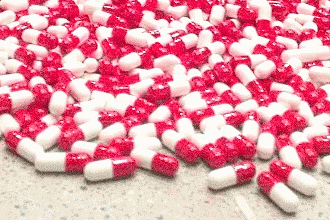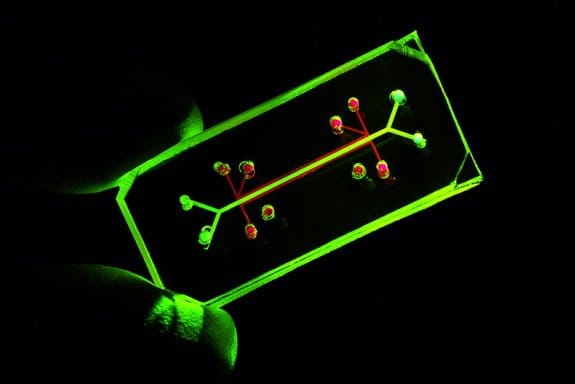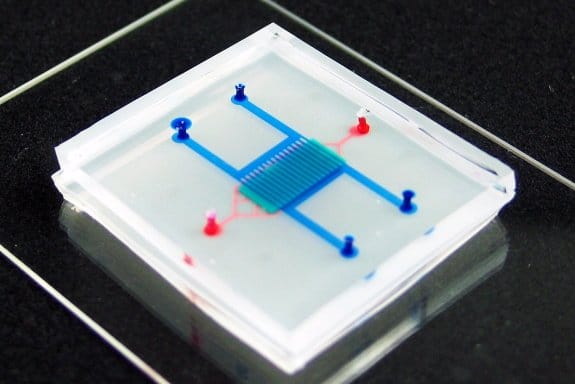Microfluidic Liver-On-a-Chip devices for more accurate drug toxicity screening in preclinical settings
The pharmaceutical industry can see a significant boost by the development of in vitro models with better predictive potentials for drug toxicity screening. A biologically relevant in vitro model with tunable modalities can impact and shift the current drug toxicity screening paradigm. Drug testing can include devices or protocols for metabolism studies of the drug as well as the absorption of the compound.
Failure to predict the drug’s actual response in vivo can be a major reason for the failure of many new medicines in the development process. Therefore, it is crucial to develop a platform for screening the metabolism of candidate drugs. This will allow a more accurate prediction of pharmacokinetics/pharmacodynamics (PK-PD) and bioactivity of the potential new compound.
The liver is an important organ with key roles in metabolism that affects the PK-PD response of the drugs. Thus, here we have provided a short review of the potential of Microfluidics in developing microphysiological systems (MPS) for mimicking the metabolic activities of the liver, also called Liver Chips, in response to a new drug formulation.
Current in vitro models
All in vitro models are developed to mimic the in vivo conditions and also to reduce the number of animal models required for experiments. Another disadvantage of the animal tests is that the tests with animal models could be time-consuming and take time to lead to results. Also, the response of animal models is not necessarily the same as humans and extrapolating animal behavior to humans can be troublesome. Therefore, an accurate and reliable in vitro model with acceptable biological relevancy is a crucial component for toxicity testing of a new medicine formulation.
Conventional static 2D cell cultures include Petri dishes, well plates, and cell culture flasks. Although they are very powerful tools for quick and high-throughput screening of one or several parameters, conventional in vitro models fail to recapitulate the in vivo habitat of the cells leading to unreliable toxicity results. Conventional 2D models are not capable of mimicking many features of the cells including cell-cell and cell-matrix interaction. More advanced models incorporating microfluidic technology have been developed recently allowing a biologically relevant environment to be made for the cell culture.
Microfluidic liver-on-a-chips: Powerful tools for drug toxicity testing
The in vitro models are essential for screening the absorption, distribution, metabolism, excretion, and toxicity (ADME-tox) of new formulations. From those that exhibit proper ADME-tox behavior and transfer to the next stages including animal testing and clinical tests, only a very small percentage end up appearing on the market. A considerable amount of the failures could be due to the incompetency of the preclinical in vitro models and animal tests in predicting the toxicity levels of the new compound. Therefore, there is a demand for more sophisticated in vitro models of the organs influenced by the drug such as the liver.
An important feature of microfluidic tissue chips, also known as organ-on-a-chip, is the control over the microenvironment as well as the flow of the nutrients and the media. The precise control over the cell culture zone in organ-on-a-chip microfluidics devices allows a biologically relevant environment to be tailored according to the needs of the experiment. Liver-on-a-chip microfluidics devices (also called liver-on-chip) are excellent examples of these microfluidic chips. In a liver-on-a-chip, hepatocytes or a co-culture of hepatocytes and other types of cells present in the liver are cultured in a microfluidic chamber under highly supervised conditions. The cells in the liver-on-a-chip can then be exposed to various compound and their response be monitored in real-time.
Metabolism on a chip: Things to consider
 Various organs such as the gut and kidneys can be involved in drug metabolism. However, the liver is the one with the highest metabolic activity. The liver has a significant role in determining the toxicity of a drug due to its importance in the metabolism and excretion of the external compounds.
Various organs such as the gut and kidneys can be involved in drug metabolism. However, the liver is the one with the highest metabolic activity. The liver has a significant role in determining the toxicity of a drug due to its importance in the metabolism and excretion of the external compounds.
An important aspect of drug metabolism is to make the molecules ready for excretion. Most of the drugs are lipid-soluble and cannot be excreted into bodily fluids. Hepatic metabolism transforms them into water-soluble molecules and prepares them for excretion. In principle, the metabolism of a drug reduces its effect. However, in prodrugs such as codeine, the parent drug is inactive and needs to be activated by getting metabolized. In general, this process involves breaking down a parent drug leading to its elimination. However, in some cases, the metabolite might be harmful and reactive. Build up of these toxic metabolites can cause drug-induced liver injury (DILI). Drug-induced liver failure is the reason behind the majority of liver failures.
The performance and functionality of the liver organ-on-a-chip microfluidics device are related to the cell type used in the system. The liver cells can be obtained from various resources. This can affect their functionality and the pharmacokinetics and toxicity testing results from the microfluidics organ-on-a-chip. Thus, a major concern for in vitro modeling of the liver is the cell source. 60% of the liver is composed of the hepatocytes as the parenchymal cells while multiple other non-parenchymal cells constituting the other 40%. The hepatocytes can be derived from human primary cells, animal-based cells, induced pluripotent stem cells (iPSCs), or immortalized cell lines. Some of the commonly used hepatocyte cell lines include HepG2, HepaRG, Huh7, Hep3B, and SK-HEP-1. The non-parenchymal portion of the liver cells can be a mixture of endothelial cells, sinusoidal endothelial cells, Natural killers, Kupffer cells, hepatic stellate cells. Inclusion of the non-parenchymal cells could benefit the cell culture systems by enhancing the functionality of the hepatocytes.
It should be noted that in traditional cell-culture methods, such as well plates, the cells are exposed to a static culture media only. It causes the concentration of the substrates to decrease over time and potentially affect the metabolism. Also, when the cells metabolize the contents, the metabolites accumulate in the surrounding causing a build-up of the metabolites until the media is refreshed. This is not similar to the natural body conditions where body there is a continuous flow of body fluids that can wash off the metabolites. Microfluidic devices, in contrast, provide a continuous flow of the media and growth factors to the cells allowing new substrates to be delivered to the cells. This helps in maintaining the metabolism rate within the cell culture during the tests. Although this allows a more realistic environment to be made for the cells, it requires careful calculations of the flow rates and mass transport rates. Flow rates, concentrations, volume ratio, and the contact area can affect the metabolism rate and should be taken into account.
Real-time monitoring of the metabolites using microfluidics electrochemical sensors
As mentioned earlier, the liver-on-a-chip offers a dynamic environment for cell culture. This dynamic environment calls for real-time analysis of the metabolism rather than conventional end-point examination. Microfluidic chips may be fabricated to be modular and enable electrodes and monitoring systems to be employed in the cell culture. Therefore, the analysis is not limited to the end-point analysis and the effect of various elements on metabolism can be monitored in real-time. Electrochemical sensors are common in this regard. The majority of the sensors used to measure the metabolism have been employed for adherent cells. Very few systems have been reported for non-adherent cells. These electrochemical sensors can be used for measuring the following parameters:
– Oxygen (Indicative of respiration)
– Glucose and Lactate consumption (representative of energy metabolism)
– pH (Acidification indicator)
– Reactive species (such as ROS or RNS)
The metabolism rate can be monitored by placing measurement electrodes underneath the culture chambers or the collection microfluidic channels and reading out the metabolite concentrations. The position of the electrodes depends on their functionality and the intended application. For example, some enzyme-based electrodes can produce hydrogen peroxide and are recommended to be placed near the outlets rather than the culture microchamber.
The electrodes vary in size and can shrink to micrometer range enabling localized metabolism measurement. However, it should be noted that decreasing the microelectrode size and increasing the number of microelectrodes results in fetching a high volume of data that requires proper data analysis to lead to meaningful results.
Further Reading
- Metabolic patterning on a chip: Towards in vitro liver zonation of primary rat and human hepatocytes
- Assessment of metabolism-dependent drug efficacy and toxicity on a multilayer organs-on-a-chip
- A microfluidic device for a pharmacokinetic–pharmacodynamic (PK–PD) model on a chip
- Microengineered bioartificial liver chip for drug toxicity screening
- Microsensor systems for cell metabolism – from 2D culture to organ-on-chip
- Organs-on-a-chip: Current applications and consideration points for in vitro ADME-Tox studies
- Liver ‘organ on a chip’
- Microfluidic devices for in vitro studies on liver drug metabolism and toxicity
- Organ-on-a-chip technology and microfluidic whole-body models for pharmacokinetic drug toxicity screening
Not only microfluidics chips can be used to synthesize potential medicine molecules; but also to test how these chemical molecules bind to biological targets.
Discover the advancements of the microfluidics approaches for recapitulating the brain function on brain-on-chip devices.
Heart-on-chip microfluidics devices employ microfluidic technology and tissue engineering principles to create functional models of the heart.





